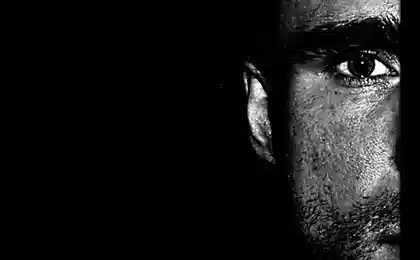416
A sore subject: how to stop being a hypochondriac?
Hypochondria is not a disease. And yet at times it causes such suffering, as if people really unhealthy. International classification of diseases (ICD-10) today describes hypochondriacal disorder (F45.2) so:
"The most important feature [hypochondriacal disorders] is a steady concern patient the possibility to have severe, progressive disease or several diseases. The patient shows stable somatic complaints or exhibits a consistent concern with their occurrence. Normal, ordinary feelings and symptoms are often perceived by patients as abnormal and disturbing; it concentrates usually on only one or two organs or systems of the body. There is often severe depression and anxiety, which may explain the additional diagnoses. Disorder, manifested in concern for own health".

© Picasso, "Femme aux Bras Croisês"
Before you put a diagnosis of "hypochondria" is to know what somatoform disorders to which it relates. Their main feature — the distrust of doctors: patients-hypochondriacs make their claims again require surveys and analyses, even if the results were negative. The existing somatic (i.e., not caused by mental activity) of the disease it does not explain what the patient complains.
In other words, not everyone who painfully and unjustifiably suspects have breast cancer or AIDS are hypochondriacs: many will forget about the anxiety, as soon as the doctor says that all is well. Nevertheless, due to the flow of alarming information that hits us, even mentally healthy people often suffer from fear.
The kantserofobiey
One of the most common forms of hypochondria — kantserofobiey, in which a healthy person is afraid of getting cancer. It affects many different people around the world — because many people know that cancer is a common cause of death (conceding, however, the cardiovascular diseases that no one is as much afraid of), and the treatment they are not all easy to carry.
The kantserofobiey occurs for different reasons. The basis for her including can be:
1)reaction to the death of a loved one from cancer;
2) reaction to surgery to remove benign tumors or cysts;
3) review of the doctor during examination (review perceived as a hint or warning);
4) the presence of precancerous lesions (cervical erosion, gastric ulcer, etc.);
5) obsessive-compulsive disorder, hypochondria, personality disorder, depression, schizophrenia;
6) generalized anxiety disorder;
7) chronic stress, which is accompanied by sudden weight loss;
8) chronic pain syndrome (e.g., migraine);
9) menopause is when a woman is forced to undergo regular medical examinations.
Advertising of medicinal and prophylactic agents, which allegedly prevents the development of malignant tumors, also adds to people's confidence in the future and in fact how would push them to think: "if I have cancer?".
All this, of course, does not mean you have to ignore the warning signs, attributing them solely kantserofobii. However, it is necessary to distinguish its effect from the really important changes in health status. One of the best ways to do this (and to cope with the kantserofobiey, as with other such States), is to go to the doctor. As frightening as this may seem the need ("And suddenly you find anything?"), usually, the visit to the clinic ends with a sense of relief. This step is visit a doctor should be seen as therapy, an effective way to cope with the horror that long did not give rest. The kantserofobiey constantly diverts attention, makes you listen to yourself, to locate lists of symptoms, and frightened still more.
If the fear after treatment to doctors persists or if the person knows that he has obsessive-compulsive disorder, hypochondria, personality disorder, depression, schizophrenia, anxiety disorder or other problems, to cope with the phobia together with a major mental illness — help psychotherapy. To maintain the health of the psyche is as necessary as to treat the teeth or ears, and there is absolutely no reason to be shy (after all, we are not ashamed of what was at the dentist or Laura).
Fear of developing schizophrenia
Fear of becoming a victim of mental illness, it seems, is not so common as kantserofobiey, but it is a serious problem. Most often, this phobia is accompanied by other disturbances of the psyche (but never combined with the schizophrenia): neurosis, obsessive-compulsive disorder, panic attacks, and depression. In other words, if a person is afraid to go crazy or watching themselves characteristic symptoms of schizophrenic disorders, it means that it is healthy or almost healthy. Real schizophrenia will never suspect it: on the contrary, due to the so-called delusional awareness of what is happening (is a condition when the surrounding of the schizophrenic "strange" finally add up to a coherent picture of the global scale), it would seem that it is with others that something is wrong.
However, obsessive fear of insanity — lyssophobia — requires treatment by the therapist. From schizophrenia in that case will not treat a schizophrenic will not name, but will help to cope with substantive, real problem, which is not crazy.
The Fear Of AIDS
Many urban legends have inspired fear. These include, for example, the myth of a vengeful patient who puts in the seats in movie theaters and metro soiled in the blood pins and notes: "Now you have AIDS!". Also people are often afraid of Contracting HIV or hepatitis in the dentist's office, the blood test, nail salon, etc.
The truth is, according to the site Aids.ru still, there was not a single case of HIV transmission from patient to patient in the dental office. All tools here are strict sterilization: first, they bathe in a special solution, then sealed in air-tight bags and sent to the autoclave. He, due to the high temperature and steam under pressure ensures absolute sterilization. While all the tools are there indicators that show whether they are sterile. And for doctors who are at particular risk in each dental office is the so-called "AIDS-laying" ("form 50") that allows you to provide first aid if the medic cut or pricked.
HIV cannot be become infected by shaking hands using towels, linen, clothes, in the pool, through mosquito bites, kissing, notorious injections in the transport of syringes in the clinic, and in nail salons. Today, 30 years after the beginning of the AIDS epidemic, we know that this virus is only transmitted during unprotected sexual contact, injection with shared instruments, from mother to child during pregnancy, childbirth and breastfeeding. If the person complies with elementary precautions, HIV is difficult and to protect yourself from it, on the contrary, very easy. published
P. S. And remember, just changing your mind - together we change the world! © Join us at Facebook , Vkontakte, Odnoklassniki
Source: theoryandpractice.ru
"The most important feature [hypochondriacal disorders] is a steady concern patient the possibility to have severe, progressive disease or several diseases. The patient shows stable somatic complaints or exhibits a consistent concern with their occurrence. Normal, ordinary feelings and symptoms are often perceived by patients as abnormal and disturbing; it concentrates usually on only one or two organs or systems of the body. There is often severe depression and anxiety, which may explain the additional diagnoses. Disorder, manifested in concern for own health".

© Picasso, "Femme aux Bras Croisês"
Before you put a diagnosis of "hypochondria" is to know what somatoform disorders to which it relates. Their main feature — the distrust of doctors: patients-hypochondriacs make their claims again require surveys and analyses, even if the results were negative. The existing somatic (i.e., not caused by mental activity) of the disease it does not explain what the patient complains.
In other words, not everyone who painfully and unjustifiably suspects have breast cancer or AIDS are hypochondriacs: many will forget about the anxiety, as soon as the doctor says that all is well. Nevertheless, due to the flow of alarming information that hits us, even mentally healthy people often suffer from fear.
The kantserofobiey
One of the most common forms of hypochondria — kantserofobiey, in which a healthy person is afraid of getting cancer. It affects many different people around the world — because many people know that cancer is a common cause of death (conceding, however, the cardiovascular diseases that no one is as much afraid of), and the treatment they are not all easy to carry.
The kantserofobiey occurs for different reasons. The basis for her including can be:
1)reaction to the death of a loved one from cancer;
2) reaction to surgery to remove benign tumors or cysts;
3) review of the doctor during examination (review perceived as a hint or warning);
4) the presence of precancerous lesions (cervical erosion, gastric ulcer, etc.);
5) obsessive-compulsive disorder, hypochondria, personality disorder, depression, schizophrenia;
6) generalized anxiety disorder;
7) chronic stress, which is accompanied by sudden weight loss;
8) chronic pain syndrome (e.g., migraine);
9) menopause is when a woman is forced to undergo regular medical examinations.
Advertising of medicinal and prophylactic agents, which allegedly prevents the development of malignant tumors, also adds to people's confidence in the future and in fact how would push them to think: "if I have cancer?".
All this, of course, does not mean you have to ignore the warning signs, attributing them solely kantserofobii. However, it is necessary to distinguish its effect from the really important changes in health status. One of the best ways to do this (and to cope with the kantserofobiey, as with other such States), is to go to the doctor. As frightening as this may seem the need ("And suddenly you find anything?"), usually, the visit to the clinic ends with a sense of relief. This step is visit a doctor should be seen as therapy, an effective way to cope with the horror that long did not give rest. The kantserofobiey constantly diverts attention, makes you listen to yourself, to locate lists of symptoms, and frightened still more.
If the fear after treatment to doctors persists or if the person knows that he has obsessive-compulsive disorder, hypochondria, personality disorder, depression, schizophrenia, anxiety disorder or other problems, to cope with the phobia together with a major mental illness — help psychotherapy. To maintain the health of the psyche is as necessary as to treat the teeth or ears, and there is absolutely no reason to be shy (after all, we are not ashamed of what was at the dentist or Laura).
Fear of developing schizophrenia
Fear of becoming a victim of mental illness, it seems, is not so common as kantserofobiey, but it is a serious problem. Most often, this phobia is accompanied by other disturbances of the psyche (but never combined with the schizophrenia): neurosis, obsessive-compulsive disorder, panic attacks, and depression. In other words, if a person is afraid to go crazy or watching themselves characteristic symptoms of schizophrenic disorders, it means that it is healthy or almost healthy. Real schizophrenia will never suspect it: on the contrary, due to the so-called delusional awareness of what is happening (is a condition when the surrounding of the schizophrenic "strange" finally add up to a coherent picture of the global scale), it would seem that it is with others that something is wrong.
However, obsessive fear of insanity — lyssophobia — requires treatment by the therapist. From schizophrenia in that case will not treat a schizophrenic will not name, but will help to cope with substantive, real problem, which is not crazy.
The Fear Of AIDS
Many urban legends have inspired fear. These include, for example, the myth of a vengeful patient who puts in the seats in movie theaters and metro soiled in the blood pins and notes: "Now you have AIDS!". Also people are often afraid of Contracting HIV or hepatitis in the dentist's office, the blood test, nail salon, etc.
The truth is, according to the site Aids.ru still, there was not a single case of HIV transmission from patient to patient in the dental office. All tools here are strict sterilization: first, they bathe in a special solution, then sealed in air-tight bags and sent to the autoclave. He, due to the high temperature and steam under pressure ensures absolute sterilization. While all the tools are there indicators that show whether they are sterile. And for doctors who are at particular risk in each dental office is the so-called "AIDS-laying" ("form 50") that allows you to provide first aid if the medic cut or pricked.
HIV cannot be become infected by shaking hands using towels, linen, clothes, in the pool, through mosquito bites, kissing, notorious injections in the transport of syringes in the clinic, and in nail salons. Today, 30 years after the beginning of the AIDS epidemic, we know that this virus is only transmitted during unprotected sexual contact, injection with shared instruments, from mother to child during pregnancy, childbirth and breastfeeding. If the person complies with elementary precautions, HIV is difficult and to protect yourself from it, on the contrary, very easy. published
P. S. And remember, just changing your mind - together we change the world! © Join us at Facebook , Vkontakte, Odnoklassniki
Source: theoryandpractice.ru
In spite of everything: does it make sense to maintain the relationship for the kids?
How to choose a partner horoscope: building a perfect relationship























